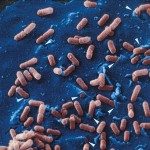Link to Pubmed [PMID] – 24345743
MBio 2013;4(6):e00542-13
Candida albicans invades endothelial cells by binding to N-cadherin and other cell surface receptors. This binding induces rearrangement of endothelial cell actin microfilaments, which results in the formation of pseudopods that surround the organism and pull it into the endothelial cell. Here, we investigated the role of endothelial cell septin 7 (SEPT7) in the endocytosis of C. albicans hyphae. Using confocal microscopy, we determined that SEPT7 accumulated with N-cadherin and actin microfilaments around C. albicans as it was endocytosed by endothelial cells. Affinity purification studies indicated that a complex containing N-cadherin and SEPT7 was recruited by C. albicans and that formation of this complex around C. albicans was mediated by the fungal Als3 and Ssa1 invasins. Knockdown of N-cadherin by small interfering RNA (siRNA) reduced recruitment of SEPT7 to C. albicans, suggesting that N-cadherin functions as a link between SEPT7 and the fungus. Also, depolymerization of actin microfilaments with cytochalasin D decreased the association between SEPT7 and N-cadherin and inhibited recruitment of both SEPT7 and N-cadherin to C. albicans, indicating the necessity of an intact cytoskeleton in the functional interaction between SEPT7 and N-cadherin. Importantly, knockdown of SEPT7 decreased accumulation of N-cadherin around C. albicans in intact endothelial cells and reduced binding of N-cadherin to this organism, as revealed by the affinity purification assay. Furthermore, SEPT7 knockdown significantly inhibited the endocytosis of C. albicans. Therefore, in response to C. albicans infection, SEPT7 forms a complex with endothelial cell N-cadherin, is required for normal accumulation of N-cadherin around C. albicans hyphae, and is necessary for maximal endocytosis of the organism.

